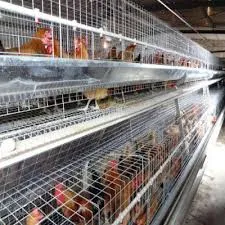Exploring Modern Solutions for Efficient Chicken Housing and Welfare Practices
Dec . 11, 2024 01:08 Back to list
Exploring Modern Solutions for Efficient Chicken Housing and Welfare Practices
The Evolution and Significance of Chicken Cages in Poultry Farming
Chicken cages have become a fundamental part of poultry farming, enabling large-scale production of eggs and meat while optimizing space and resources. The evolution of chicken cages has been driven by the increasing demand for poultry products and the need for efficient farming practices. Understanding their design, benefits, and the ethical debates surrounding them provides a comprehensive view of their role in modern agriculture.
The Evolution and Significance of Chicken Cages in Poultry Farming
Modern chicken cages come in various designs, primarily categorized into battery cages, enriched cages, and free-range systems. Battery cages, common in large commercial operations, are compact and house multiple hens in limited space. While they maximize production, they have been criticized for their restrictions on natural behaviors, such as nesting and perching. In response to growing ethical concerns, many farms have transitioned to enriched cages that provide slightly more space and offer features like nesting boxes and perches, allowing hens to exhibit some natural behaviors.
chick cages

The benefits of using chicken cages in poultry farming are extensive. From a production perspective, they enable farmers to control environmental conditions, such as temperature and lighting, which can enhance egg-laying rates and overall flock health. Cages also minimize the risk of disease outbreaks, as they keep hens separate and reduce the likelihood of transmission. Moreover, the efficient use of space in cage systems allows for higher stocking densities, leading to increased productivity and profitability for farmers.
However, the ethical implications of chicken cages cannot be overlooked. Animal welfare advocates argue that confinement in small spaces denies birds the ability to express natural behaviors, leading to stress and health issues. This has sparked debates and legislative changes in several regions, prompting some countries to ban battery cages altogether. Consumers are increasingly demanding humane farming practices, leading to a rise in organic and free-range egg production.
In response to these evolving consumer preferences, many poultry producers are exploring alternative farming practices. Free-range systems allow chickens to roam outside, providing them with more space and social interactions. While these systems may have higher production costs and lower yields, they appeal to a growing segment of the market that prioritizes animal welfare. Additionally, certifications such as cage-free or pasture-raised have emerged, providing consumers with transparency regarding farming practices and enabling them to make informed choices.
In conclusion, chicken cages play a significant role in poultry farming, balancing efficiency and production with ethical considerations. As the industry continues to evolve, farmers are tasked with meeting consumer demands for animal welfare while still maintaining productivity. Innovations in cage design and management practices will likely shape the future of poultry farming, ensuring that it remains viable in an increasingly conscientious market. The challenge lies in finding sustainable solutions that honor both the welfare of the birds and the agricultural demands of society, reflecting a nuanced approach to modern farming practices.
-
Hot Sale 24 & 18 Door Rabbit Cages - Premium Breeding Solutions
NewsJul.25,2025
-
Automatic Feeding Line System Pan Feeder Nipple Drinker - Anping County Yize Metal Products Co., Ltd.
NewsJul.21,2025
-
Automatic Feeding Line System Pan Feeder Nipple Drinker - Anping County Yize Metal Products Co., Ltd.
NewsJul.21,2025
-
Automatic Feeding Line System - Anping Yize | Precision & Nipple
NewsJul.21,2025
-
Automatic Feeding Line System - Anping Yize | Precision & Nipple
NewsJul.21,2025
-
Automatic Feeding Line System-Anping County Yize Metal Products Co., Ltd.|Efficient Feed Distribution&Customized Animal Farming Solutions
NewsJul.21,2025






